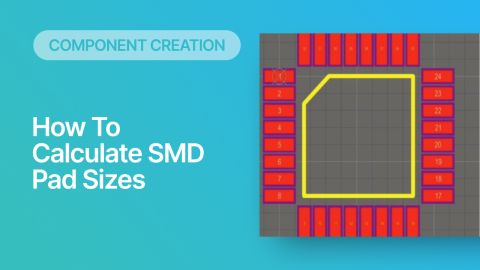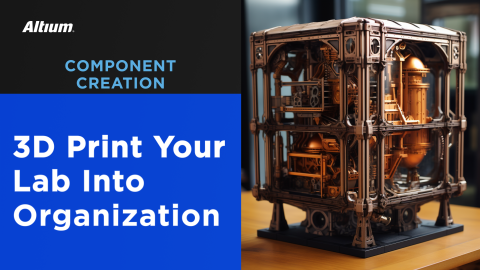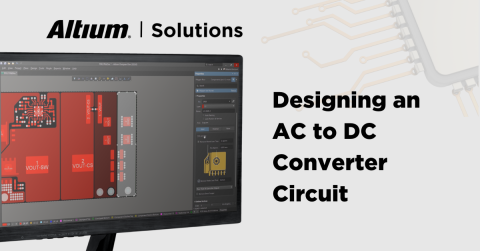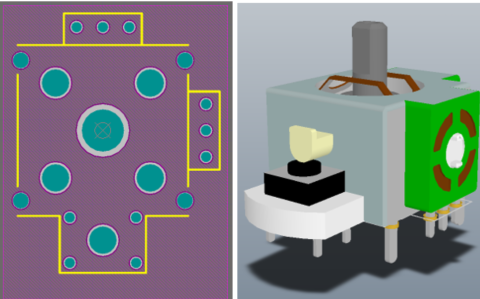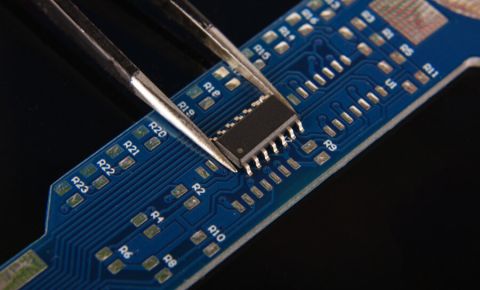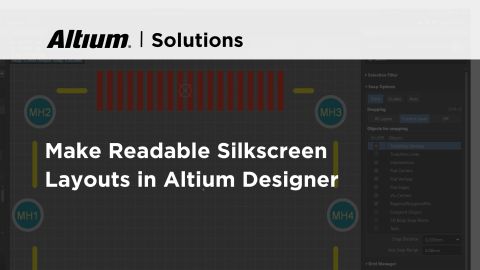PCB Temperature Won’t Overheat with Smart Checking Design Software

Board integrity can be compromised without a conscious effort by the designer to mitigate high temperature board areas. Heat management can help keep your board from catching aflame.
ALTIUM DESIGNER
The right board design software will go a long way in high-speed designs and beyond.
The emphasis on achieving smaller product footprints has pushed multi-layer PCB designs toward higher component densities. As a result, the application of better thermal design techniques has become a priority. Higher operating temperatures can lead to mechanical stresses for the board that lead to cracking and intermittent or failed connections as layers heat and cool. Thermal design involves understanding how heating occurs, how different components and layer materials respond to heat, and how to properly remove heat from the PCB laminate materials.
High Temperatures Can Damage Layer Integrity
Expressed as parts per million per degree Celsius (ppm/oC), the coefficient of thermal expansion (CTE) describes how PCB Laminate expands when heated or cooled. To place this in perspective, Printed Circuit Boards expand in length, width, and thickness as the temperature rises. As an example, common FR-4 laminate expands 14 to 17 ppm/oC. When we compare the laminate rate of expansion with the rate of expansion for components such as ICs or BGAs, a significant difference exists between the expansion rates of the components and the laminate materials. The results of the difference become apparent as broken connections or circuit instability. If the laminate and the component have similar CTEs, both expand and contract without causing any damage.
The plastic packaging used with components has high thermal resistance. As a result, heat transfers to the exposed copper pad of the PCB prototype. Because of the potential for damage at those points of lower thermal resistance, Altium Designer provides high-quality information about thermal interface materials and the correct placement of heat sinks. As an example, thermally connecting the heat sink to the opposite side of the board from a surface-mounted component keeps the temperature of the system in tolerance. In some instances, though, manufacturers may produce packages that require the attachment of the heat sink to the top of the component.
Choose the Right Thermal Interface Materials for Your PCB
Altium Designer uses component information and analysis tools to determine the use of thermal relief patterns and teardrops for strengthening track-to-pad, track-to-via, and track-to-track connections. Altium Designer provides the right thermal relief pattern for any via or hole connected to a power or ground plane. The thermal reliefs conduct heat away from components by thermally connecting the components to adjacent copper planes.
Heat transfer through an exposed pad illustrates that maximum heat transfer occurs at the PCB. As you design your PCB, Altium Designer will assist with determining the thermal resistance of the Circuit Board. As Altium Designer determines the paths that heat can take to move from a component junction to the ambient air, it defines thermal performance parameters for each layer of your PCB. From there, you can use Altium Designer to establish the Electrical Rules Check (ERC) and Design Rules Check (DRC) for your PCB design and to verify that your PCB meets all established thermal design constraints.
- Knowing when to use thermal pads or thermal paste can be the first step in determining how you are going to layout your board. Learn more about choosing between thermal pads and paste.
- Heat management can be a design issue in most boards, so knowing how to mitigate the risks associated can be immensely valuable. Learn more about design tips for heat management in PCBs.
- There are many ways to alleviate heat problems in your circuit board. Learn more about passive heat dissipation techniques.

Teardrops reduce mechanical and thermal stresses by supporting copper where the traces join the pads.
Use Best Practices in Thermal Design
High-power Circuit Boards' designs generate heat and—as a result—require best practices that allow heat to dissipate. Those best practices include reducing the case-to-ambient thermal resistance (ƟCAfor integrated circuits found within your PCB design. Controlling the thermal resistance through proper dissipation techniques increases the reliability of your Printed Circuit Board.
Good thermal design and the proper thermal interface materials for PCBs can improve reliability and prevent damage to components as well as the flexible PCB. However, the path leading to good thermal design often involves performing a mathematical analysis of fluid dynamics for complex geometries. Rather than attempting to perform that analysis, you can depend on the analyses provided through Altium Designer to define which materials and methods work best for thermal control. The analyses provided through Altium Designer consider thermal design early in the PCB design process.
For example, you can avoid redesign after the post-layout phase by using PI-DC (DC Power Integrity) analysis within PDN Analyzer (Power Delivery Network Analyzer) application to optimize your design for the lowest current density and voltage drop between the sources and all loads. PDN Analyzer ensures that the planes, traces, and vias on a PCB have the size and characteristics needed to meet the power consumption needs of components mounted on the board. Maintaining the integrity of the DC power layout and optimizing your design lessens the opportunities for thermal issues.
Altium Designer and PDN Analyzer Provide the Tools Needed to Identify Problem Components
With Altium Designer, you have access to the thermal resistance information for more than 300,000 components along with recommended guidelines, availability, and cost estimates. Your access to the component libraries provides power dissipation values for the components and allows you to edit and attach any concerns about thermal characteristics directly to the components. In turn, you can use PDN Analyzer--a downloadable Altium Designer extension—to extract all physical and electrical information from the PCB design.
Tools found within the PDN Analyzer application identify hot spots during component placement and generate a thermal map based on the power dissipation values of components. Then, you can use approximations of the real temperature profile for each component to consider the thermal interactions of the circuit.
High-power, high-frequency power amplifiers generate heat that can damage device junctions or active devices close to the amplifiers. Altium Designer also assists with placing components for the even distribution of heat across the PCB. With the correct component placement, your PCB can transfer energy away from surface-mounted power components.
- Thankfully, Altium has a series of videos documenting tips and guidance on thermal management and thermal resistance. Learn more about thermal management and thermal resistance.
- Material selection choices can impact the temperature limits of your PCB. Learn more materials used in your PCBs like FR4.
- PDN analyzers can save you an immense amount of time and money before shipping your boards off for prototyping or manufacturing. Learn more about why you need a PDN analyzer.

Utilizing Altium Designer’s PDN analyzer can make your designs infinitely more reliable.
Convenient PCB Editor Enables Designs to Run Flawlessly
In addition, Altium Designer assists you with selecting low-CTE materials for your high-temperature application. Altium’s Layer Stack Manager allows you to choose dielectrics that have the correct glass transition temperature (Tg), the laminate dielectric constant (Dk), and dissipation factor (Df) for your application. For example, high-temperature PCBs require a Tg greater than 170oC and should handle a continuous thermal load with an operating temperature approximately 25oC below the Tg. The layer stack table found within the Layer Stack Manager specifies the material and mechanical requirements for each layer type. Always consult with the board fabricator to select the right materials and properties for your PCB design.
Altium Designer’s Design Integration from Schematic to Layout Ensures Solidarity
Altium Designer’s PCB Editor provides the foundation for design rules. You can the Editor to establish design rules that:
- Remain separate from objects
- Work as targets as defined by a flexible query system
- Apply to any design situation
- Have priorities
- Define the required behavior of an object, and
- Determine the interaction between two objects.
Having a smart rules and constraints editor can help manage anything from PCB materials to the impact that soldering and reflow might have on your design. But furthermore, having a design rules checker is just another part of the process which enables you to move from schematic to layout to production seamlessly
.
- Being able to set a design rule checker that will regularly catch any potential design flaws is a lifesaver for a designer. Learn more about Altium Designer’s intuitive design rules environment.
- Component selection, especially when trying to mitigate thermal needs for your board, can become a bear to handle. Learn more about how Altium Designer makes component selection easy.
- High-speed design is one of many potential design avenues that will, inevitably, run into thermal management problems. Learn more about how Altium Designer enables high-speed design.
Using Altium Designer to identify thermal design issues requires a methodical approach combined with different levels of Thermal analysis software. Altium Designer and the PDN Analyzer reduce the complexity of thermal design through tools such as comprehensive component libraries and simulations.



